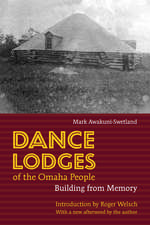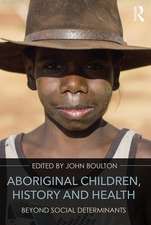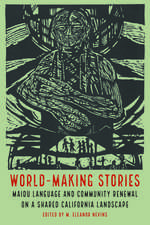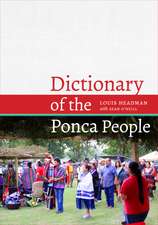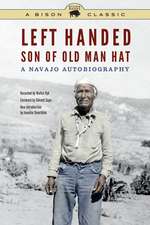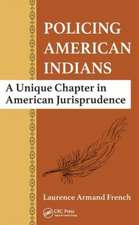The Omaha Language and the Omaha Way: An Introduction to Omaha Language and Culture
Editat de Mark Awakuni-Swetlanden Limba Engleză Paperback – 31 iul 2018
Published through the Recovering Languages and Literacies of the Americas initiative, supported by the Andrew W. Mellon Foundation
The Omaha Language and the Omaha Way provides a comprehensive textbook for students, scholars, and laypersons to learn to speak and understand the language of the Omaha Nation. Mark Awakuni-Swetland, Vida Woodhull Stabler, Aubrey Streit Krug, Loren Frerichs, and Rory Larson have collaborated with elder speakers, including Alberta Grant Canby, Emmaline Walker Sanchez, Marcella Woodhull Cavou, and Donna Morris Parker, to write this book.
The original and creative pedagogical method used in this textbook—teaching the Omaha language through Omaha culture—consists of a structured series of lesson plans. It is the result of a generous collaboration between the Department of Anthropology at the University of Nebraska–Lincoln and the Umóⁿhoⁿ Language and Culture Center at Umóⁿhoⁿ Nation Public School in Macy, Nebraska. The method draws on the accumulated wisdom and knowledge of Awakuni-Swetland to illustrate the Omaha values of balance and integration. The contents are shaped into two parts, each of which complements the other—just as the Earth and Sky do.
This textbook features an introduction by Awakuni-Swetland on the history and phonology of the Omaha language; lessons from the Umóⁿhoⁿ Language and Culture Center at Macy, with a writing system quick sheet; situation quick sheets; lessons on games; lessons on spring, summer, fall, and winter; an Omaha language resource list; and a glossary in the standard Macy orthography of the Omaha language. The textbook also includes cultural lessons in the language by Awakuni-Swetland and lessons from the Omaha language class at the University of Nebraska–Lincoln.
The Omaha Language and the Omaha Way offers a linguistic foundation for tribal members, students, scholars, and laypersons, featuring Omaha community lessons, the standard Macy orthography, and UNL orthography all under one cover.
The Omaha Language and the Omaha Way provides a comprehensive textbook for students, scholars, and laypersons to learn to speak and understand the language of the Omaha Nation. Mark Awakuni-Swetland, Vida Woodhull Stabler, Aubrey Streit Krug, Loren Frerichs, and Rory Larson have collaborated with elder speakers, including Alberta Grant Canby, Emmaline Walker Sanchez, Marcella Woodhull Cavou, and Donna Morris Parker, to write this book.
The original and creative pedagogical method used in this textbook—teaching the Omaha language through Omaha culture—consists of a structured series of lesson plans. It is the result of a generous collaboration between the Department of Anthropology at the University of Nebraska–Lincoln and the Umóⁿhoⁿ Language and Culture Center at Umóⁿhoⁿ Nation Public School in Macy, Nebraska. The method draws on the accumulated wisdom and knowledge of Awakuni-Swetland to illustrate the Omaha values of balance and integration. The contents are shaped into two parts, each of which complements the other—just as the Earth and Sky do.
This textbook features an introduction by Awakuni-Swetland on the history and phonology of the Omaha language; lessons from the Umóⁿhoⁿ Language and Culture Center at Macy, with a writing system quick sheet; situation quick sheets; lessons on games; lessons on spring, summer, fall, and winter; an Omaha language resource list; and a glossary in the standard Macy orthography of the Omaha language. The textbook also includes cultural lessons in the language by Awakuni-Swetland and lessons from the Omaha language class at the University of Nebraska–Lincoln.
The Omaha Language and the Omaha Way offers a linguistic foundation for tribal members, students, scholars, and laypersons, featuring Omaha community lessons, the standard Macy orthography, and UNL orthography all under one cover.
| Toate formatele și edițiile | Preț | Express |
|---|---|---|
| Paperback (1) | 267.54 lei 22-36 zile | |
| Nebraska – 31 iul 2018 | 267.54 lei 22-36 zile | |
| Hardback (1) | 494.26 lei 22-36 zile | |
| Nebraska – 31 iul 2018 | 494.26 lei 22-36 zile |
Preț: 267.54 lei
Nou
Puncte Express: 401
Preț estimativ în valută:
51.19€ • 53.59$ • 42.36£
51.19€ • 53.59$ • 42.36£
Carte disponibilă
Livrare economică 17-31 martie
Preluare comenzi: 021 569.72.76
Specificații
ISBN-13: 9781496200440
ISBN-10: 1496200446
Pagini: 736
Ilustrații: 191 illustrations; 193 tables; 1 map, 3 photographs, 19 figures
Dimensiuni: 216 x 279 x 32 mm
Greutate: 1.61 kg
Editura: Nebraska
Colecția University of Nebraska Press
Locul publicării:United States
ISBN-10: 1496200446
Pagini: 736
Ilustrații: 191 illustrations; 193 tables; 1 map, 3 photographs, 19 figures
Dimensiuni: 216 x 279 x 32 mm
Greutate: 1.61 kg
Editura: Nebraska
Colecția University of Nebraska Press
Locul publicării:United States
Notă biografică
Mark Awakuni-Swetland (1956–2015) was an associate professor of anthropology and ethnic studies at the University of Nebraska–Lincoln, principal co-investigator for the Omaha and Ponca Digital Dictionary, and a coordinator for the Omaha Language Curriculum Development Project. He is the author of Dance Lodges of the Omaha People: Building from Memory (Nebraska, 2008) and the editor of the Omaha and Ponca Digital Dictionary.
Recenzii
"Taken as a whole, the volume represents an active guide to the intertwined language and culture of the Omaha people. It is an essential tool for anyone who wishes to begin the path to a fluency in the Omaha language as well as for others whose goals may be less ambitious, but who wish to know and appreciate the people of this important Native American nation."—Michael J. Smith, Nebraska History
“This book, whose subject matter is critically important for any member of the Omaha Nation, can help a reader move from being someone who is simply looking to say a few words in Omaha to someone who can read, write, and speak Omaha at a conversational level. I consider it a major contribution to its field.”—Ryan Kasak, doctoral candidate in linguistics at Yale University
Cuprins
Preface
Guide for Readers
Contributors: Umóⁿhoⁿ Language and Culture Center, Umóⁿhoⁿ Nation Public School, and Omaha Language Instruction Team, University of Nebraska–Lincoln
Illustrators
Introduction by Mark Awakuni-Swetland, Wagōⁿze Ūthix̣ide
Part 1. Lessons from the Umóⁿhoⁿ Language and Culture Center, Umóⁿhoⁿ Nation Public School, Macy, Nebraska
1. Beginning Resources
1.1 Writing System Quick Sheet: Umóⁿhoⁿ Íye-tʰe Áwatʰegoⁿ Baxú-Noⁿ
1.2 Articles
1.3 Elders’ Verb Patterns
2. Situation Quick Sheets
2.1 Guide to Using Quick Sheets: Wagthábaze Úmakʰa
2.2 Animal Characteristics: Waníta Úshkoⁿ
2.3 Animal Drawing: Waníta Gthíxu-a/ga
2.4 Animal Names: Waníta Izházhe Etái-ge
2.5 Birthday Celebration Phrases
2.6 Classroom Phrases for Action Verbs
2.7 Classroom Phrases for Asking and Talking: Wémoⁿxe tʰe, Íye Uthá
2.8 Classroom Phrases for Beginning of Class
2.9 Classroom Phrases for Ending/Leaving: Aíathai-ki Uthá
2.10 Classroom Phrases for Places and Movement
2.11 Classroom Phrases for Praise and Caring: Óⁿxtiwathe, Wathánoⁿbe, Wákʰihide Uthá 2.12 Classroom Phrases for Teaching: Wégoⁿze-doⁿ Uthá
2.13 Clothing and Weather: Háthe-tʰe Óⁿba-akʰa-shti
2.14 Coffee Phrases: Moⁿkóⁿsabe Uthá
2.15 Coffee Script: Moⁿkóⁿsabe Uthá Ukíkʰia
2.16 Colors: Úgaxe Ázhi-thoⁿthoⁿ
2.17 Days of the Week
2.18 Doings Phrases: Úzhawa Íye
2.19 Doings Cultural Note
2.20 Door-Answering Phrases for See You Later, Greetings
2.21 Five Senses: Wíubesni Sátoⁿ
2.22 Baking a Cake: Wamóⁿske Skíthe Oⁿgúhoⁿi-tʰe
2.23 Praying Over Food: Oⁿwóⁿhoⁿ’a
2.24 Sitting Around the Table: Wáthatʰe Uthíshoⁿ Oⁿgthíⁿ
2.25 Four Directions/Points of a Compass
2.26 Four Seasons
2.27 Handgame Greetings: Íⁿ’utʰiⁿ Thatʰí
2.28 Handgame Setup and Instruments
2.29 Handgame Encouragements and Gameplay
2.30 Handgame Gameplay Phrases: Íⁿ’utʰiⁿ Shkáde-kʰe Uthá
2.31 Handgame Q&A
2.32 Handgame Worksheet 1
2.33 Handgame Worksheet 2
2.34 Handgame Flyer
2.35 Handwashing: Noⁿbé Kigthízha-tʰe
2.36 Household Objects: Iⁿdádoⁿ-shte Tí-adi-ge
2.37 Inviting and Visiting: Wéku Tiúpe Éthoⁿba
2.38 In the Kitchen: Úhoⁿ Tí-adi
2.39 Money: Móⁿzeska
2.40 Months of the Umóⁿhoⁿ Calendar Year: Mí-kʰe
2.41 Numbers: Watháwa
2.42 Opposites
2.43 Outside and Play: Áshi Shkáde Thé-Wathe
2.44 Relationship Terms: Éawathe
2.45 Restroom Phrases: Tí Zhiⁿga Uthá
2.46 Telephone Phrases: Móⁿze Íutha Uthá
2.47 Time (Telling Time from the Clock): Miídoⁿbe Ánoⁿ-a?
2.48 Time (Yesterday, Today, Tomorrow): Sidádi Óⁿbathe Gasóⁿthiⁿ
2.49 Time of Day
2.50 Umóⁿhoⁿ Language Pledge: Wóⁿgithe Oⁿthípʰi
2.51 Wellness Actions and the Four Hills of Life Wellness Center: Niyé Thiⁿgé Tí-adi Wágazhi, Pahé Dúba Níta Moⁿthíⁿ
3. Games: Úshkade
3.1 Games How-To
3.2 Card Game Play Phrases: Wathíbaba Íshkade Uthá
3.3 Boardgame Play Phrases: Zhoⁿbtháska Áshkade Uthá
3.4 Ballgame Play Phrases: Tabé Íshkade Uthá
3.5 Go Fish Phrases: Hugási Moⁿthiⁿ-a/ga Uthá
3.6 An Umóⁿhoⁿ Card Game: Tóⁿkawe
3.7 Real Estate Boardgame Phrases
3.8 Grandma Says: Thikóⁿ Áthigazhi
3.9 Natural Body Action/Total Physical Response
3.10 I’m Sorry: Uthúama
3.11 Pokeno Phrases: Pokeno Uthá
3.12 You’re in Trouble Phrases: Píazhi Shkáxe Uthá
3.13 It Will Fall Phrases: Uxpáthe-taakʰa Uthá
3.14 Twist and Bend Your Body: Zhú Thibéni
3.15 Blackjack Phrases: Gthéboⁿ Noⁿbá Kʰi Édi Wiⁿóⁿxchi Uthá
3.16 Darts Phrases: Móⁿdehi Óⁿtha Thétha/ga Uthá
3.17 Badminton/Racquetball: Wazhíⁿga Zhiⁿga Utʰíⁿ-a/ga
3.18 Jump Rope and Tug-of-War Phrases: Házhiⁿga U’óⁿsisi, Házhiⁿga Thidóⁿ Uthá 4. Summer: Nugé Moⁿshté
4.1 “Taps” Song and Memorial Day
4.2 Names of Months
4.3 Milkweed and Berries: Waxthá Waxtá Skíthe Éthoⁿba
4.4 Nature Walk Lesson Plan
4.5 Umóⁿhoⁿ Language and Culture Center Mission Statement
4.6 High School Umóⁿhoⁿ Íye 1, 2, and 3 Scope and Sequence
4.7 First Days of School and Basic Self-Introductions
4.8 Self-Introduction Basic Curriculum: Ebé Bthíⁿ-tʰe Uwíbtha-tamiⁿkʰe
4.9 Clothing and Weather: Háthe, Moⁿshté
4.10 Umóⁿhoⁿ Flag Song
4.11 Húthuga: Wayne Tyndall-akʰa Húthuga Uthái-tʰe
4.12 Harvest Celebration: Hédewachʰi/Hethúshka
4.13 Harvest Celebration Phrases: Hédewachʰi/Hethúshka Uthá
4.14 Umóⁿhoⁿ Regalia, Men’s and Women’s: Nú Wáthaha, Wa’ú Wáthaha
4.15 Sewing Phrases: Wabátʰe Uthá
4.16 The First Umóⁿhoⁿ Powwow Princess: Míⁿdashoⁿthiⁿ (Gerine Woodhull Davidson)
4.17 Zoo: Waníta Tí-ata Thé-Wathe
4.18 Grocery Shopping: Pahóⁿga Úthiwiⁿ Tí-ata Oⁿgáthai-tʰe
4.19 Sweet Drinks: Nískithe
4.20 Banana Splits: Waxtáthiguzhe Másne
4.21 Funerary Sayings: Wat’é-kʰe Wagíxe-tʰe-shti Uthá
4.22 Grief in Our Umóⁿhoⁿ Community: Útiha
5. Fall: Toⁿgáxthoⁿ
5.1 Names of Months
5.2 Cheers for the Chiefs: Níkagahi Moⁿthíⁿi-a/ga
5.3 Fall Phrases: Toⁿgáxthoⁿ Uthá
5.4 Justin McCauley’s Cougar Story: Justin-akʰa Waníta Dóⁿbai-tʰe Ugthá Góⁿtha
5.5 Homecoming Float
5.6 Candy Action: Zhoⁿní Thatʰé-Wathe
5.7 Tribal Council Phrases: Gahíye Uthá
5.8 Halloween Phrases
5.9 Halloween Silly Questions and Answers
5.10 Halloween Drawing Scene
5.11 Pin the Bone on the Skeleton Game
5.12 Flag Pledge
5.13 Corn Removal, Student Worksheet
5.14 Corn Removal, Teacher Handout
5.15 Coloring Activity for Food o’ Plenty: Tehéxthu’a
5.16 Thanksgiving Day Foods: Wathátʰe Toⁿga Óⁿbathe
5.17 Set the Food Out: Wathátʰe-tʰe Áwa-ta Itʰéathe-a?
5.18 Thanksgiving Color Sheet Phrases: Wagthábaze Ugá
5.19 Thanksgiving Day Verbs, “I Like” and “I Don’t Like”: Xtáathe, Xtháatha-mazhi
5.20 Thanksgiving Bingo, Today Is Turkey Day: Zizíka Óⁿbathe
5.21 Thanksgiving Fill-in-the-Blanks Handout
5.22 Birds Go South
6. Winter: Mágashude
6.1 Names of Months
6.2 Clothing and Weather: Háthe, Usní
6.3 Self-Introductions: Additional Phrases and Tisha Webster’s Example
6.4 Basketball Phrases: Tabé Ugásnoⁿ Shkádai-tʰe Úwatha
6.5 Ceremonial Ball Toss: Tabé Óⁿtha Thétha
6.6 Globe Toss Game: Áwa-kʰe-ta Né-a?
6.7 Conjugation Activity: “Múzhoⁿ Thishtóⁿ”
6.8 Walnut and Corn Mush Story: Táge Washóⁿge Íutha
6.9 “Deck the Halls”: Wíuga Nákoⁿ Tʰigthágtha
6.10 What Did Ned Eat?: Ned Iⁿdádoⁿ Thatʰé-a?
7. Spring: Mépahoⁿga
7.1 Names of Months
7.2 First Thunder: Lawrence Cook-akʰa Mépahoⁿga Uthái-tʰe
7.3 Rainstick Activity with Weather Terms
7.4 Spring Tree Ornaments
7.5 Easter Phrases
7.6 Dyeing Easter Eggs
7.7 Hunting Eggs: Wéta Íthathe-a?
7.8 Egg Salad Sandwiches/Deviled Eggs: Wéta Wamóⁿska Ubískabe/Wéta Uzí Ígahi
7.9 Mushroom Search: Teníxa Ugthézhe Oⁿgúnai-tʰe
7.10 Mushroom Worksheet and Games 1
7.11 Mushroom Worksheet and Games 2
7.12 Fried Mushrooms: Teníxa Ugthézhe Zhézhi
7.13 How the Umóⁿhoⁿ Got the Corn: Té-akʰa Umóⁿhoⁿ-ma Wahába-tʰe Wa’í-biama
7.14 Put Up the Tipi: Timóⁿgthe
7.15 Kickball: Tabé Noⁿtʰá
7.16 Earth Day/Mother Earth: Íⁿnoⁿha Tóⁿde
7.17 Standing Bear Speech: Maⁿchʰú Nazhiⁿ Íya-biama
7.18 Mother’s Day Phrases: Ihóⁿ Óⁿba Íye-ge
7.19 Flower Pots and Flower Planting: Waxchá Úzhi
7.20 Dining-Out Script
7.21 What Will You Do in the Summer?: Moⁿshté-ki Iⁿdádoⁿ Shkáxe-taniⁿkshe?
7.22 Graduation Phrases
8. Additional Resources
8.1 Writing System Extension, How It Is Written in Umóⁿhoⁿ: Umóⁿhoⁿ Íye-tʰe Áwatʰegoⁿ Baxú-Noⁿ
8.2 Umóⁿhoⁿ Resource List
8.3 ulcc Glossary in Macy Standard Orthography: Umóⁿhoⁿ to English
8.4 ulcc Glossary in Macy Standard Orthography: English to Umóⁿhoⁿ Part 2: Lessons from the Omaha Language Class at the University of Nebraska–Lincoln
9. Cultural Lessons by Mark Awakuni-Swetland, Wagōⁿze Ūthix̣ide
9.1 What Is Culture? What Is Language?
9.2 First Catch, First Fruits
9.3 How to Ask Someone for Help
9.4 Knife and Fire
9.5 The Spirit World
9.6 Food and the Spirits
9.7 Arriving at and Leaving an Umóⁿhoⁿ Campsite
9.8 First Thunders
9.9 The Four Hills of Life
9.10 Generosity and Gift Giving
9.11 Carrying Dishes to a Feast
9.12 Storytelling
9.13 The Omaha Handgame: Íⁿˀutʰíⁿ, “Strike the Stone”
10. Introduction and Phonology
10.1 Welcome
10.2 Siouan Languages
10.3 Omaha Sounds: Oral Vowels and h
10.4 Omaha Sounds: Nasals
10.5 Omaha Sounds: Stops
10.6 Omaha Sounds: Fricatives
10.7 Omaha Sounds: Affricates
10.8 Omaha Sounds: Semivowels and Ledh
10.9 Omaha Sounds: Glottals
10.10 Consonant Clusters
10.11 Vowel Length and Accent
11. Expressions and Word Order
11.1 Nouns: “Who” and “What”
11.2 Verbs: What Is Someone Doing?
11.3 Adjectives: Stative Verbs
11.4 Numbers: “How Many”
11.5 Unitary Utterances
11.6 Useful Omaha Expressions
11.7 Noun-Noun Word Order
11.8 Noun–Stative Verb Word Order
11.9 Noun–Active Verb Word Order
11.10 Verb Chaining
12. Demands and Ablaut
12.1 Commands: The Particles a and ga
12.2 Commands: Ablaut
12.3 Plural Commands: i and Ablaut
12.4 Questions: a with No Ablaut
12.5 Third-Person Statement of Action: Ablaut for Declaration
12.6 Negation: Ablaut before “Not”
12.7 The Potential Particle tte
12.8 The Hearsay Particle Set bi ama
12.9 Signaling Demand in English and Omaha
13. Verb Conjugation
13.1 Affixed Pronouns: I and You Common Forms
13.2 Affixed Pronouns: I and You for Ledh Verbs
13.3 Affixed Pronouns: I and You for Verbs Beginning with Simple Stops
13.4 Affixed Pronouns: I and You for Verbs Beginning with Simple Stop g-
13.5 Affixed Pronouns: I and You for Old Glottal Stop Verbs and “say”
13.6 Affixed Pronouns: We
13.7 Person and Number of the Subject
13.8 Person and Number: Negation
13.9 Patient-Affixed Pronouns
13.10 Patient-Affixed Pronouns for ā-, í, and u- Verbs
13.11 Agent-to-Patient Affixed Pronoun Combinations
13.12 Subject-Affixed Pronouns for Stative Verbs
14. Pronouns and Positionals
14.1 Inanimate Positionals
14.2 Active Subject Positionals
14.3 Animate Positionals
14.4 Articles
14.5 Future
14.6 Demonstratives: This and That
14.7 Demonstrative Pronouns
14.8 Emphatic Pronouns
14.9 Possessive Pronouns
15. Location, Motion, and Continuity
15.1 Postpositions
15.2 Positionals and Postpositions
15.3 Location Nouns and Adverbs
15.4 Verbs of Motion
15.5 Verbs of Motion with the a- Prefix
15.6 Return Verbs of Motion
15.7 Conjugating Verbs of Motion
15.8 Verb Chaining and Continuatives
15.9 Positionals as Continuatives
15.10 Declaration of Existence Using Positionals
16. Kinship and Causative Constructions
16.1 Grandparents and Grandchildren
16.2 Parents and Children
16.3 Siblings
16.4 Uncles and Aunts, Nieces and Nephews
16.5 Spouses and In-Laws
16.6 Causatives: The Basic Construction with -the
16.7 Conjugation of the Causative
16.8 The Dative Causative: -kʰithe
16.9 The Causative of Potentiality: -wathe
16.10 Causatives and Kinship
17. Instrumental Prefixes
17.1 thi- “by hand”
17.2 tha- “by mouth”
17.3 noⁿ- “by foot”
17.4 ba- “by pushing”
17.5 bi- “by pressure” or “by blowing”
17.6 ga- “by force”
17.7 nā- “by fire”
17.8 mā- “by cutting”
17.9 mū- “by shooting”
18. Locative Prefixes and wa-
18.1 The wa- Prefix
18.2 The ī- Prefix
18.3 The Locative u- Prefix
18.4 Conjugation of Locative u- Verbs
18.5 The Locative ā- Prefix
18.6 Conjugation of Locative ā- Verbs
18.7 The Transitivizing í- Prefix
18.8 Conjugation of Transitivizing í- Verbs
18.9 Combinations of Applicative ī and í- with Locative u- and ā- Prefixes
18.10 Combination of wa- with Locative u- and ā-, and ī-, and í- Verbs
19. Self Affixes and Datives
19.1 The Possessive gi- Prefix
19.2 The Suus gi- Prefix
19.3 The Reflexive kki- Prefix
19.4 The Victimized kke- Prefix and Evidential tʰe
19.5 The Dative gi̅- and -ī-
19.6 Conjugation of the Dative
20. Answer Keys
21. unl Glossary in unl Orthography
21.1 Umóⁿhoⁿ Orthography
21.2 Umóⁿhoⁿ Alphabet
21.3 Glossary: Umóⁿhoⁿ to English
21.4 Glossary: English to Umóⁿhoⁿ
Words of Encouragement
Guide for Readers
Contributors: Umóⁿhoⁿ Language and Culture Center, Umóⁿhoⁿ Nation Public School, and Omaha Language Instruction Team, University of Nebraska–Lincoln
Illustrators
Introduction by Mark Awakuni-Swetland, Wagōⁿze Ūthix̣ide
Part 1. Lessons from the Umóⁿhoⁿ Language and Culture Center, Umóⁿhoⁿ Nation Public School, Macy, Nebraska
1. Beginning Resources
1.1 Writing System Quick Sheet: Umóⁿhoⁿ Íye-tʰe Áwatʰegoⁿ Baxú-Noⁿ
1.2 Articles
1.3 Elders’ Verb Patterns
2. Situation Quick Sheets
2.1 Guide to Using Quick Sheets: Wagthábaze Úmakʰa
2.2 Animal Characteristics: Waníta Úshkoⁿ
2.3 Animal Drawing: Waníta Gthíxu-a/ga
2.4 Animal Names: Waníta Izházhe Etái-ge
2.5 Birthday Celebration Phrases
2.6 Classroom Phrases for Action Verbs
2.7 Classroom Phrases for Asking and Talking: Wémoⁿxe tʰe, Íye Uthá
2.8 Classroom Phrases for Beginning of Class
2.9 Classroom Phrases for Ending/Leaving: Aíathai-ki Uthá
2.10 Classroom Phrases for Places and Movement
2.11 Classroom Phrases for Praise and Caring: Óⁿxtiwathe, Wathánoⁿbe, Wákʰihide Uthá 2.12 Classroom Phrases for Teaching: Wégoⁿze-doⁿ Uthá
2.13 Clothing and Weather: Háthe-tʰe Óⁿba-akʰa-shti
2.14 Coffee Phrases: Moⁿkóⁿsabe Uthá
2.15 Coffee Script: Moⁿkóⁿsabe Uthá Ukíkʰia
2.16 Colors: Úgaxe Ázhi-thoⁿthoⁿ
2.17 Days of the Week
2.18 Doings Phrases: Úzhawa Íye
2.19 Doings Cultural Note
2.20 Door-Answering Phrases for See You Later, Greetings
2.21 Five Senses: Wíubesni Sátoⁿ
2.22 Baking a Cake: Wamóⁿske Skíthe Oⁿgúhoⁿi-tʰe
2.23 Praying Over Food: Oⁿwóⁿhoⁿ’a
2.24 Sitting Around the Table: Wáthatʰe Uthíshoⁿ Oⁿgthíⁿ
2.25 Four Directions/Points of a Compass
2.26 Four Seasons
2.27 Handgame Greetings: Íⁿ’utʰiⁿ Thatʰí
2.28 Handgame Setup and Instruments
2.29 Handgame Encouragements and Gameplay
2.30 Handgame Gameplay Phrases: Íⁿ’utʰiⁿ Shkáde-kʰe Uthá
2.31 Handgame Q&A
2.32 Handgame Worksheet 1
2.33 Handgame Worksheet 2
2.34 Handgame Flyer
2.35 Handwashing: Noⁿbé Kigthízha-tʰe
2.36 Household Objects: Iⁿdádoⁿ-shte Tí-adi-ge
2.37 Inviting and Visiting: Wéku Tiúpe Éthoⁿba
2.38 In the Kitchen: Úhoⁿ Tí-adi
2.39 Money: Móⁿzeska
2.40 Months of the Umóⁿhoⁿ Calendar Year: Mí-kʰe
2.41 Numbers: Watháwa
2.42 Opposites
2.43 Outside and Play: Áshi Shkáde Thé-Wathe
2.44 Relationship Terms: Éawathe
2.45 Restroom Phrases: Tí Zhiⁿga Uthá
2.46 Telephone Phrases: Móⁿze Íutha Uthá
2.47 Time (Telling Time from the Clock): Miídoⁿbe Ánoⁿ-a?
2.48 Time (Yesterday, Today, Tomorrow): Sidádi Óⁿbathe Gasóⁿthiⁿ
2.49 Time of Day
2.50 Umóⁿhoⁿ Language Pledge: Wóⁿgithe Oⁿthípʰi
2.51 Wellness Actions and the Four Hills of Life Wellness Center: Niyé Thiⁿgé Tí-adi Wágazhi, Pahé Dúba Níta Moⁿthíⁿ
3. Games: Úshkade
3.1 Games How-To
3.2 Card Game Play Phrases: Wathíbaba Íshkade Uthá
3.3 Boardgame Play Phrases: Zhoⁿbtháska Áshkade Uthá
3.4 Ballgame Play Phrases: Tabé Íshkade Uthá
3.5 Go Fish Phrases: Hugási Moⁿthiⁿ-a/ga Uthá
3.6 An Umóⁿhoⁿ Card Game: Tóⁿkawe
3.7 Real Estate Boardgame Phrases
3.8 Grandma Says: Thikóⁿ Áthigazhi
3.9 Natural Body Action/Total Physical Response
3.10 I’m Sorry: Uthúama
3.11 Pokeno Phrases: Pokeno Uthá
3.12 You’re in Trouble Phrases: Píazhi Shkáxe Uthá
3.13 It Will Fall Phrases: Uxpáthe-taakʰa Uthá
3.14 Twist and Bend Your Body: Zhú Thibéni
3.15 Blackjack Phrases: Gthéboⁿ Noⁿbá Kʰi Édi Wiⁿóⁿxchi Uthá
3.16 Darts Phrases: Móⁿdehi Óⁿtha Thétha/ga Uthá
3.17 Badminton/Racquetball: Wazhíⁿga Zhiⁿga Utʰíⁿ-a/ga
3.18 Jump Rope and Tug-of-War Phrases: Házhiⁿga U’óⁿsisi, Házhiⁿga Thidóⁿ Uthá 4. Summer: Nugé Moⁿshté
4.1 “Taps” Song and Memorial Day
4.2 Names of Months
4.3 Milkweed and Berries: Waxthá Waxtá Skíthe Éthoⁿba
4.4 Nature Walk Lesson Plan
4.5 Umóⁿhoⁿ Language and Culture Center Mission Statement
4.6 High School Umóⁿhoⁿ Íye 1, 2, and 3 Scope and Sequence
4.7 First Days of School and Basic Self-Introductions
4.8 Self-Introduction Basic Curriculum: Ebé Bthíⁿ-tʰe Uwíbtha-tamiⁿkʰe
4.9 Clothing and Weather: Háthe, Moⁿshté
4.10 Umóⁿhoⁿ Flag Song
4.11 Húthuga: Wayne Tyndall-akʰa Húthuga Uthái-tʰe
4.12 Harvest Celebration: Hédewachʰi/Hethúshka
4.13 Harvest Celebration Phrases: Hédewachʰi/Hethúshka Uthá
4.14 Umóⁿhoⁿ Regalia, Men’s and Women’s: Nú Wáthaha, Wa’ú Wáthaha
4.15 Sewing Phrases: Wabátʰe Uthá
4.16 The First Umóⁿhoⁿ Powwow Princess: Míⁿdashoⁿthiⁿ (Gerine Woodhull Davidson)
4.17 Zoo: Waníta Tí-ata Thé-Wathe
4.18 Grocery Shopping: Pahóⁿga Úthiwiⁿ Tí-ata Oⁿgáthai-tʰe
4.19 Sweet Drinks: Nískithe
4.20 Banana Splits: Waxtáthiguzhe Másne
4.21 Funerary Sayings: Wat’é-kʰe Wagíxe-tʰe-shti Uthá
4.22 Grief in Our Umóⁿhoⁿ Community: Útiha
5. Fall: Toⁿgáxthoⁿ
5.1 Names of Months
5.2 Cheers for the Chiefs: Níkagahi Moⁿthíⁿi-a/ga
5.3 Fall Phrases: Toⁿgáxthoⁿ Uthá
5.4 Justin McCauley’s Cougar Story: Justin-akʰa Waníta Dóⁿbai-tʰe Ugthá Góⁿtha
5.5 Homecoming Float
5.6 Candy Action: Zhoⁿní Thatʰé-Wathe
5.7 Tribal Council Phrases: Gahíye Uthá
5.8 Halloween Phrases
5.9 Halloween Silly Questions and Answers
5.10 Halloween Drawing Scene
5.11 Pin the Bone on the Skeleton Game
5.12 Flag Pledge
5.13 Corn Removal, Student Worksheet
5.14 Corn Removal, Teacher Handout
5.15 Coloring Activity for Food o’ Plenty: Tehéxthu’a
5.16 Thanksgiving Day Foods: Wathátʰe Toⁿga Óⁿbathe
5.17 Set the Food Out: Wathátʰe-tʰe Áwa-ta Itʰéathe-a?
5.18 Thanksgiving Color Sheet Phrases: Wagthábaze Ugá
5.19 Thanksgiving Day Verbs, “I Like” and “I Don’t Like”: Xtáathe, Xtháatha-mazhi
5.20 Thanksgiving Bingo, Today Is Turkey Day: Zizíka Óⁿbathe
5.21 Thanksgiving Fill-in-the-Blanks Handout
5.22 Birds Go South
6. Winter: Mágashude
6.1 Names of Months
6.2 Clothing and Weather: Háthe, Usní
6.3 Self-Introductions: Additional Phrases and Tisha Webster’s Example
6.4 Basketball Phrases: Tabé Ugásnoⁿ Shkádai-tʰe Úwatha
6.5 Ceremonial Ball Toss: Tabé Óⁿtha Thétha
6.6 Globe Toss Game: Áwa-kʰe-ta Né-a?
6.7 Conjugation Activity: “Múzhoⁿ Thishtóⁿ”
6.8 Walnut and Corn Mush Story: Táge Washóⁿge Íutha
6.9 “Deck the Halls”: Wíuga Nákoⁿ Tʰigthágtha
6.10 What Did Ned Eat?: Ned Iⁿdádoⁿ Thatʰé-a?
7. Spring: Mépahoⁿga
7.1 Names of Months
7.2 First Thunder: Lawrence Cook-akʰa Mépahoⁿga Uthái-tʰe
7.3 Rainstick Activity with Weather Terms
7.4 Spring Tree Ornaments
7.5 Easter Phrases
7.6 Dyeing Easter Eggs
7.7 Hunting Eggs: Wéta Íthathe-a?
7.8 Egg Salad Sandwiches/Deviled Eggs: Wéta Wamóⁿska Ubískabe/Wéta Uzí Ígahi
7.9 Mushroom Search: Teníxa Ugthézhe Oⁿgúnai-tʰe
7.10 Mushroom Worksheet and Games 1
7.11 Mushroom Worksheet and Games 2
7.12 Fried Mushrooms: Teníxa Ugthézhe Zhézhi
7.13 How the Umóⁿhoⁿ Got the Corn: Té-akʰa Umóⁿhoⁿ-ma Wahába-tʰe Wa’í-biama
7.14 Put Up the Tipi: Timóⁿgthe
7.15 Kickball: Tabé Noⁿtʰá
7.16 Earth Day/Mother Earth: Íⁿnoⁿha Tóⁿde
7.17 Standing Bear Speech: Maⁿchʰú Nazhiⁿ Íya-biama
7.18 Mother’s Day Phrases: Ihóⁿ Óⁿba Íye-ge
7.19 Flower Pots and Flower Planting: Waxchá Úzhi
7.20 Dining-Out Script
7.21 What Will You Do in the Summer?: Moⁿshté-ki Iⁿdádoⁿ Shkáxe-taniⁿkshe?
7.22 Graduation Phrases
8. Additional Resources
8.1 Writing System Extension, How It Is Written in Umóⁿhoⁿ: Umóⁿhoⁿ Íye-tʰe Áwatʰegoⁿ Baxú-Noⁿ
8.2 Umóⁿhoⁿ Resource List
8.3 ulcc Glossary in Macy Standard Orthography: Umóⁿhoⁿ to English
8.4 ulcc Glossary in Macy Standard Orthography: English to Umóⁿhoⁿ Part 2: Lessons from the Omaha Language Class at the University of Nebraska–Lincoln
9. Cultural Lessons by Mark Awakuni-Swetland, Wagōⁿze Ūthix̣ide
9.1 What Is Culture? What Is Language?
9.2 First Catch, First Fruits
9.3 How to Ask Someone for Help
9.4 Knife and Fire
9.5 The Spirit World
9.6 Food and the Spirits
9.7 Arriving at and Leaving an Umóⁿhoⁿ Campsite
9.8 First Thunders
9.9 The Four Hills of Life
9.10 Generosity and Gift Giving
9.11 Carrying Dishes to a Feast
9.12 Storytelling
9.13 The Omaha Handgame: Íⁿˀutʰíⁿ, “Strike the Stone”
10. Introduction and Phonology
10.1 Welcome
10.2 Siouan Languages
10.3 Omaha Sounds: Oral Vowels and h
10.4 Omaha Sounds: Nasals
10.5 Omaha Sounds: Stops
10.6 Omaha Sounds: Fricatives
10.7 Omaha Sounds: Affricates
10.8 Omaha Sounds: Semivowels and Ledh
10.9 Omaha Sounds: Glottals
10.10 Consonant Clusters
10.11 Vowel Length and Accent
11. Expressions and Word Order
11.1 Nouns: “Who” and “What”
11.2 Verbs: What Is Someone Doing?
11.3 Adjectives: Stative Verbs
11.4 Numbers: “How Many”
11.5 Unitary Utterances
11.6 Useful Omaha Expressions
11.7 Noun-Noun Word Order
11.8 Noun–Stative Verb Word Order
11.9 Noun–Active Verb Word Order
11.10 Verb Chaining
12. Demands and Ablaut
12.1 Commands: The Particles a and ga
12.2 Commands: Ablaut
12.3 Plural Commands: i and Ablaut
12.4 Questions: a with No Ablaut
12.5 Third-Person Statement of Action: Ablaut for Declaration
12.6 Negation: Ablaut before “Not”
12.7 The Potential Particle tte
12.8 The Hearsay Particle Set bi ama
12.9 Signaling Demand in English and Omaha
13. Verb Conjugation
13.1 Affixed Pronouns: I and You Common Forms
13.2 Affixed Pronouns: I and You for Ledh Verbs
13.3 Affixed Pronouns: I and You for Verbs Beginning with Simple Stops
13.4 Affixed Pronouns: I and You for Verbs Beginning with Simple Stop g-
13.5 Affixed Pronouns: I and You for Old Glottal Stop Verbs and “say”
13.6 Affixed Pronouns: We
13.7 Person and Number of the Subject
13.8 Person and Number: Negation
13.9 Patient-Affixed Pronouns
13.10 Patient-Affixed Pronouns for ā-, í, and u- Verbs
13.11 Agent-to-Patient Affixed Pronoun Combinations
13.12 Subject-Affixed Pronouns for Stative Verbs
14. Pronouns and Positionals
14.1 Inanimate Positionals
14.2 Active Subject Positionals
14.3 Animate Positionals
14.4 Articles
14.5 Future
14.6 Demonstratives: This and That
14.7 Demonstrative Pronouns
14.8 Emphatic Pronouns
14.9 Possessive Pronouns
15. Location, Motion, and Continuity
15.1 Postpositions
15.2 Positionals and Postpositions
15.3 Location Nouns and Adverbs
15.4 Verbs of Motion
15.5 Verbs of Motion with the a- Prefix
15.6 Return Verbs of Motion
15.7 Conjugating Verbs of Motion
15.8 Verb Chaining and Continuatives
15.9 Positionals as Continuatives
15.10 Declaration of Existence Using Positionals
16. Kinship and Causative Constructions
16.1 Grandparents and Grandchildren
16.2 Parents and Children
16.3 Siblings
16.4 Uncles and Aunts, Nieces and Nephews
16.5 Spouses and In-Laws
16.6 Causatives: The Basic Construction with -the
16.7 Conjugation of the Causative
16.8 The Dative Causative: -kʰithe
16.9 The Causative of Potentiality: -wathe
16.10 Causatives and Kinship
17. Instrumental Prefixes
17.1 thi- “by hand”
17.2 tha- “by mouth”
17.3 noⁿ- “by foot”
17.4 ba- “by pushing”
17.5 bi- “by pressure” or “by blowing”
17.6 ga- “by force”
17.7 nā- “by fire”
17.8 mā- “by cutting”
17.9 mū- “by shooting”
18. Locative Prefixes and wa-
18.1 The wa- Prefix
18.2 The ī- Prefix
18.3 The Locative u- Prefix
18.4 Conjugation of Locative u- Verbs
18.5 The Locative ā- Prefix
18.6 Conjugation of Locative ā- Verbs
18.7 The Transitivizing í- Prefix
18.8 Conjugation of Transitivizing í- Verbs
18.9 Combinations of Applicative ī and í- with Locative u- and ā- Prefixes
18.10 Combination of wa- with Locative u- and ā-, and ī-, and í- Verbs
19. Self Affixes and Datives
19.1 The Possessive gi- Prefix
19.2 The Suus gi- Prefix
19.3 The Reflexive kki- Prefix
19.4 The Victimized kke- Prefix and Evidential tʰe
19.5 The Dative gi̅- and -ī-
19.6 Conjugation of the Dative
20. Answer Keys
21. unl Glossary in unl Orthography
21.1 Umóⁿhoⁿ Orthography
21.2 Umóⁿhoⁿ Alphabet
21.3 Glossary: Umóⁿhoⁿ to English
21.4 Glossary: English to Umóⁿhoⁿ
Words of Encouragement

